
What is DMT? Everything you need to know about this powerful psychedelic
DMT is a fast-acting psychedelic known for intense, short-lived trips. This beginner's guide explains what it is, where it comes from, how it's used, and the risks involved.
DMT is one of the most powerful and intriguing psychedelics known today. Found in various plants and used in rituals by Indigenous cultures for generations, it has also gained attention more recently for the intensity and strangeness of its effects. People who take DMT often describe entering surreal worlds, meeting unusual beings, or gaining profound insights, but it's just as likely to cause confusion or fear.
This guide is designed for anyone curious about DMT and looking for a clear, honest overview. We won't tell you to try it, but we will explain what it is, how it's used, what it feels like, and what the risks are. You'll also find links to more detailed Zamnesia articles if you'd like to go deeper into specific topics.
What is DMT?
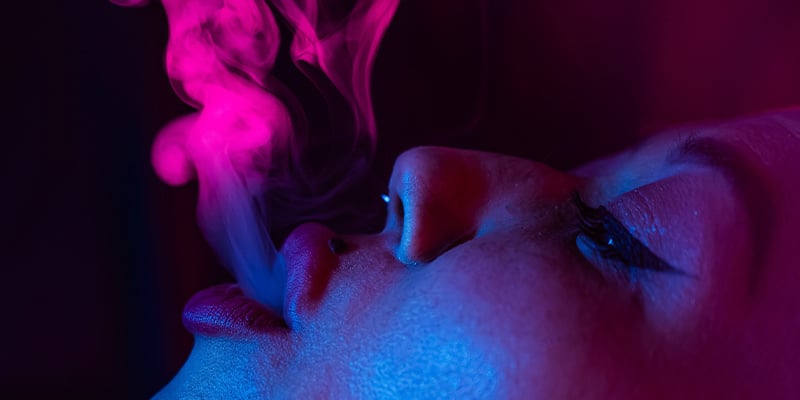
DMT (N,N-Dimethyltryptamine) is a naturally occurring psychedelic compound found in certain plants, animals, and even in the human body. Chemically speaking, it belongs to the tryptamine family, related to serotonin and melatonin. DMT is classified as a hallucinogen or psychedelic, not a stimulant or depressant.
When used in large doses, DMT can produce powerful and often overwhelming effects. People describe these as entering otherworldly realms, meeting strange beings or "entities", and experiencing what some call ego death.
Other names for DMT
DMT is also known by many other names, especially in informal or cultural contexts:
- Dimitri
- The spirit molecule
- Deems
- Changa
- Fantasia
- Spiritual molecule
- 45-minute psychosis
- Businessman's trip
What does DMT look like?
DMT can come from several plant sources, among them Psychotria viridis, Mimosa hostilis, Diplopterys cabrerana, Desmodium gangeticum, and Acacia confusa.
Depending on how it's extracted, processed, or consumed, it may appear in different forms:
- Crystalline powder (synthetic or extracted DMT): DMT in its pure form appears as white to yellowish crystals, with a dry, chalky, or slightly waxy texture.
- Changa (DMT-infused herbal blend): Changa looks like shredded herbs, dark green or brown in colour, and feels fibrous and plant-like to the touch.
- Ayahuasca or pharmahuasca (brewed oral liquid): This thick, dark brown or reddish liquid has a strong, earthy smell and a bitter taste.
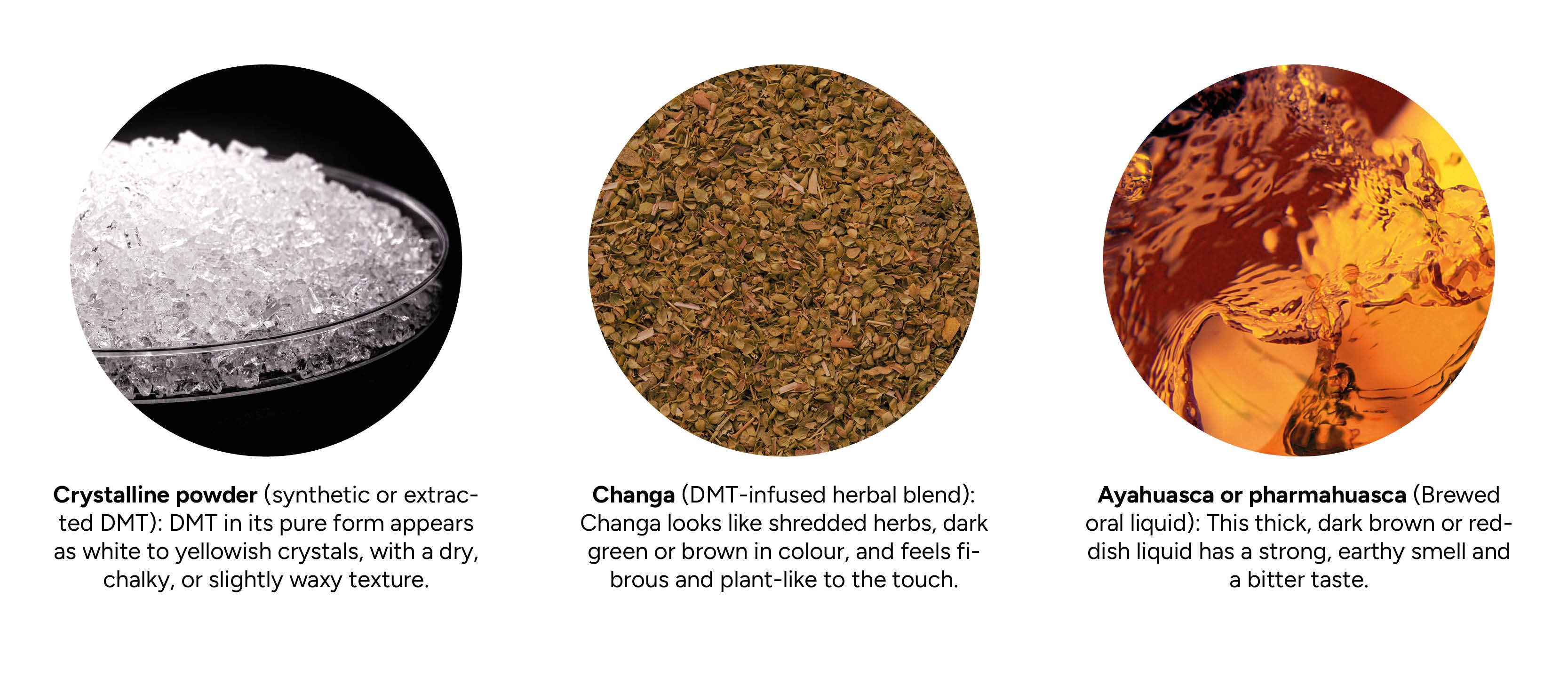
Effects of DMT
DMT produces extremely intense and unusual effects, often described as spiritual, otherworldly, or mind-expanding. People commonly report feeling detached from their body or surroundings, encountering abstract or supernatural visuals, or having deep emotional reactions. However, the experience can also be overwhelming, confusing, or frightening.
DMT can result in both positive and terrifying experiences. No two trips are the same, and individual reactions can vary greatly based on mindset, environment, and dosage. The following sections outline the short- and long-term effects to help you understand what might happen during and after a DMT experience.
Short-term effects
When smoked or vaporized, DMT takes effect quickly (usually within 15–60 seconds) and the experience reaches its peak within a few minutes. When taken orally (such as in ayahuasca), effects begin more gradually (within 30–60 minutes). The short-term effects can be grouped into mental and physical responses:
Psychological/mental effects
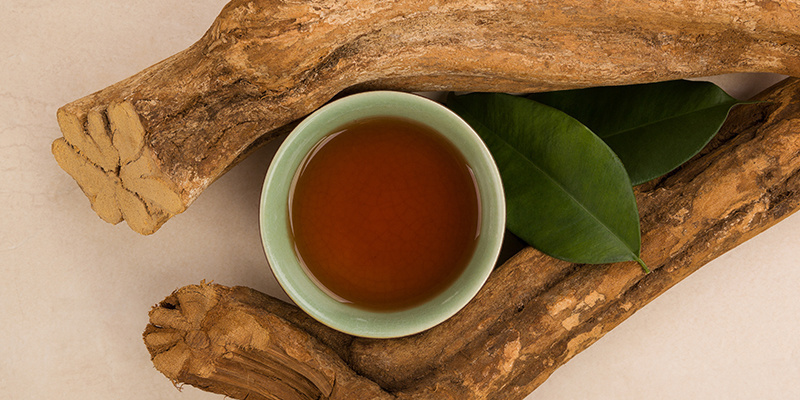
- Intense visual hallucinations (may include colours, patterns, rapid scene changes)
- Altered sense of time and space (moments may feel infinite or frozen)
- Out-of-body experience (sense of detachment from the physical self)
- Ego death (a loss of sense of self)
- Feelings of connection, spiritual insight, or contact with entities
- Enhanced emotional awareness and introspection
Physical effects
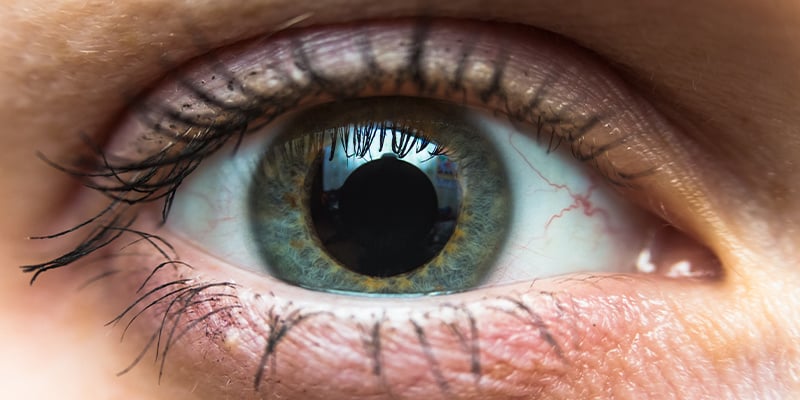
- Increased heart rate and blood pressure
- Dilated pupils
- Tremors or shaking
- Nausea or dizziness
- Breathlessness or a heavy chest sensation
Long-term effects

DMT is not known to cause physical dependence, and there are few confirmed long-term physical effects. However, some users report lingering psychological effects, particularly after high doses or difficult experiences. These include:
- Flashbacks or HPPD (hallucinogen persisting perception disorder), i.e. visual distortions returning days or weeks later
- Occasional mood shifts or anxiety following the experience
- Emotional blunting or spiritual disconnection
These effects vary widely and are not experienced by everyone. Most people do not use DMT regularly due to the intensity of the experience.
How long do the effects of DMT last?
The duration and intensity of a DMT experience vary depending on several factors: the dose, method of consumption, any other substances involved (like food or medications), and individual metabolism. Typical timelines per method are fairly well-documented, allowing users to prepare themselves accordingly. However, despite often being brief in real time, many users report that the subjective experience feels much longer due to altered time perception.
See this infographic for the duration of the effects of each consumption method.
- When smoked or vaporized, DMT acts very quickly. Effects begin within 15 to 45 seconds, peak between 2 to 5 minutes, and usually taper off within 10 to 20 minutes.
- Changa, a DMT-infused herbal blend that is typically smoked, has a slightly longer timeline. The onset starts between 30 to 90 seconds, peaks within 5 to 10 minutes, and lasts around 20 to 30 minutes in total.
- Oral DMT, such as ayahuasca or pharmahuasca, takes longer to activate. It begins working within 30 to 60 minutes, peaks at about 1 to 2 hours, and can last anywhere from 4 to 6 hours overall.
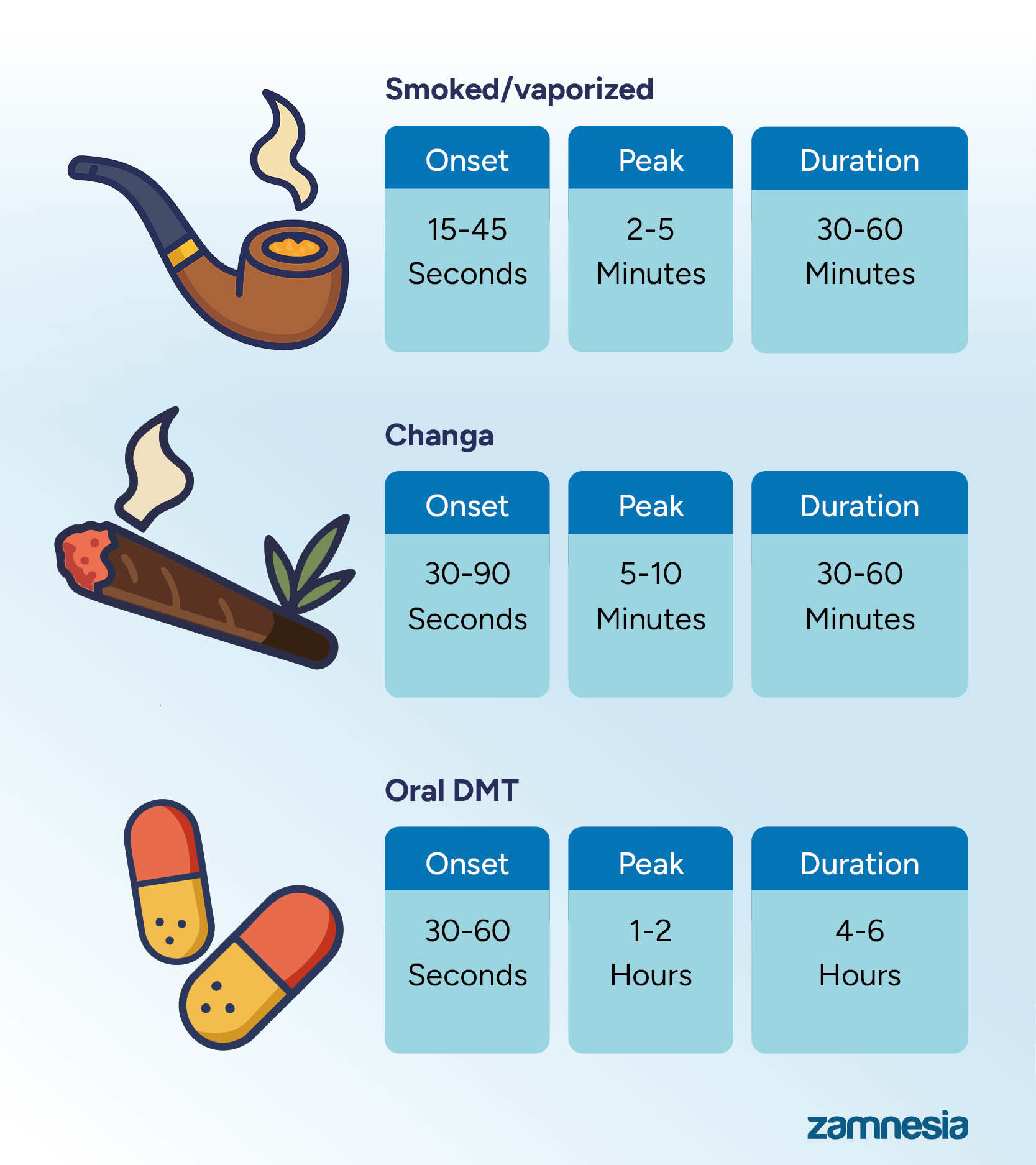
DMT vs ayahuasca
DMT is a single compound usually smoked or vaporized. Ayahuasca is a plant-based brew combining DMT with an MAOI, making it orally active and much longer lasting. Ayahuasca experiences tend to be slower, deeper, and more emotional, often accompanied by purging.
How is DMT consumed?
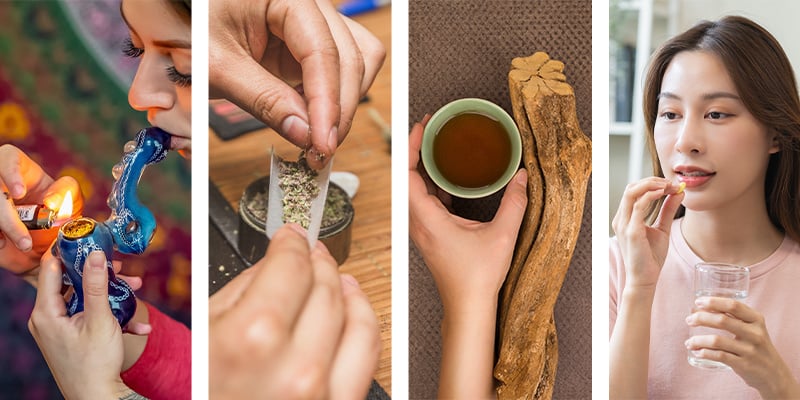
DMT can be consumed in several different ways, each producing a unique type of experience. This section explains the most common methods, focusing on how they are typically used. Note that this does not imply that we promote or encourage use.
- Smoking or vaporizing (freebase DMT): Freebase DMT is most often smoked using a glass pipe, bong, or vaporizer. It's valued for producing rapid, intense experiences often described as "breakthroughs". Because DMT is heat-sensitive, vaporization technique plays a big role. Overheating it can destroy the compound and weaken the effects.
- Smoking changa: Changa is a blend of DMT-infused herbs, typically mixed with natural MAOIs to enhance and extend the experience. It's usually smoked in a pipe or rolled into a joint, similar to cannabis. Changa tends to be more approachable for those seeking a gentler or more gradual experience than pure DMT.
- Drinking ayahuasca: Ayahuasca is a traditional brew from the Amazon made by combining a DMT-containing plant (like Psychotria viridis) with a plant containing MAOIs (like Banisteriopsis caapi). Taken orally, it produces a longer and often more emotional or purgative experience. Ceremonial use usually includes vomiting and strong emotional release, often in guided settings with spiritual intent.
- Oral consumption (DMT fumarate/pharmahuasca): Pharmahuasca involves combining DMT fumarate, a salt form of DMT suitable for oral use, with a separate MAOI. It's typically taken in capsule form and is similar to ayahuasca but allows for more precise dosing. It is usually more clinical or controlled in its effects.
Note: Combining DMT with other substances, especially alcohol or antidepressants like SSRIs, can be dangerous. Interactions with MAOIs can cause serious side effects.
Some people also explore microdosing DMT, which involves taking very small, sub-perceptual doses on a schedule. While research is still limited, it's said to produce mood and focus changes without full psychedelic effects.
Set and setting for DMT
Set and setting are crucial considerations for any psychedelic experience. Your mental state and physical environment heavily influence how the trip unfolds. DMT is not a party drug.
Risks of DMT
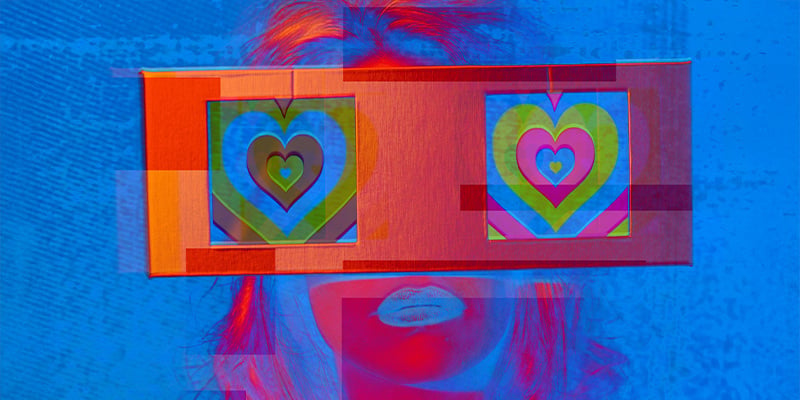
While DMT is not considered physically addictive and is often described as spiritually profound, it carries significant risks that should not be overlooked.
Psychologically, DMT can intensify underlying mental health conditions, particularly for those prone to psychosis or anxiety. The overwhelming nature of the experience may lead to lasting emotional unease, especially without adequate preparation or support. Emotional after-effects such as mood swings or lingering fear are also possible.
There's also the risk of accidental injury. During a DMT trip, users may be unaware of their physical surroundings due to intense dissociation or visual distortions. This disconnect from reality can increase the chance of falls or other accidents.
Legally, DMT is a controlled substance in most parts of the world. Possession, production, or distribution can result in serious legal consequences, depending on your location. For more detailed legal information, check the specific laws in your country.
Finally, combining DMT with other substances, especially MAOIs, antidepressants, or alcohol, can be dangerous. These combinations can cause unpredictable effects or harmful drug interactions.
For all these reasons, mental health screening and a stable, well-considered setting are essential before any use is considered.
History of DMT
DMT has a long cultural history, particularly in the Amazon, where it's used in ayahuasca ceremonies by Indigenous tribes for spiritual and healing purposes. These rituals have been practised for centuries and remain deeply important in many communities.
In Western science, DMT was first synthesised in the 1930s by Canadian chemist Richard Manske. Since then, its role has shifted, from sacred plant medicine to a subject of modern research and growing interest in psychedelic circles. This shift reflects a broader re-contextualisation of DMT in the West, where ancient traditions meet modern Western curiosity.
DMT: FAQ
Approaching DMT with respect and responsibility
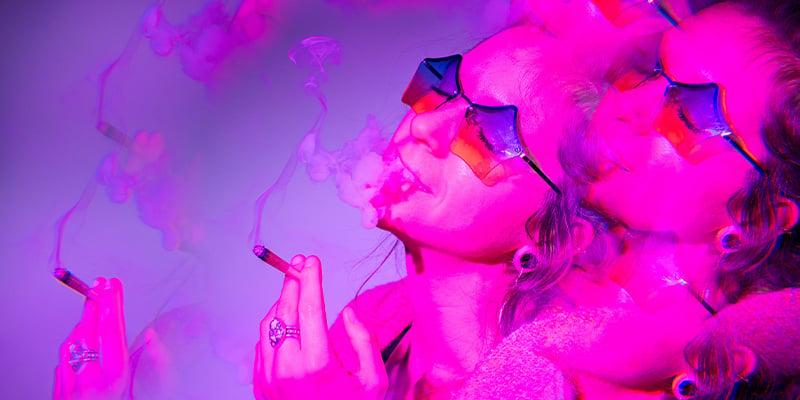
DMT is a powerful and complex psychedelic. Whether encountered through tradition, research, or personal interest, it demands careful attention to legality, preparation, and mental readiness. While some describe it as deeply meaningful or transformative, others find it overwhelming or disorienting.
If you're curious to learn more, the best next step is to explore the wider context: how DMT fits into different approaches to consciousness, healing, and personal insight. Understanding its uses, risks, and cultural relevance is part of engaging with DMT responsibly.
-
 5 min
30 June 2025
Top 10 entheogens
Used in ceremonies and healing practices for centuries, entheogens are powerful tools for spiritual exploration. Discover 10 key substances—from classics like ayahuasca and LSD to lesser-known ones...
5 min
30 June 2025
Top 10 entheogens
Used in ceremonies and healing practices for centuries, entheogens are powerful tools for spiritual exploration. Discover 10 key substances—from classics like ayahuasca and LSD to lesser-known ones...
-
 4 min
14 March 2023
Microdosing DMT: An Overview
DMT microdosing is fairly uncommon, though more and more people are trying it. There is little science one way or another to support it as a practice. Here, we look into what we know.
4 min
14 March 2023
Microdosing DMT: An Overview
DMT microdosing is fairly uncommon, though more and more people are trying it. There is little science one way or another to support it as a practice. Here, we look into what we know.
-
 4 min
18 October 2017
Can DMT Cause An Outer Body Experience?
Out of body experiences, abbreviated to OOBE, is a phenomenon achievable by anyone with some practice. Many prefer to call it “astral projection.” To some people, it happens naturally. For most,...
4 min
18 October 2017
Can DMT Cause An Outer Body Experience?
Out of body experiences, abbreviated to OOBE, is a phenomenon achievable by anyone with some practice. Many prefer to call it “astral projection.” To some people, it happens naturally. For most,...
-
 2 min
17 February 2016
Was Moses High On DMT?
DMT has influenced many cultures throughout time, but now it has been suggested it shaped on much closer to home.
2 min
17 February 2016
Was Moses High On DMT?
DMT has influenced many cultures throughout time, but now it has been suggested it shaped on much closer to home.









 United States
United States













